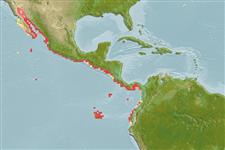>
Eupercaria/misc (Various families in series Eupercaria) >
Labridae (Wrasses) > Corinae
Etymology: Halichoeres: Greek, als, alis = salt + Greek, choiros = pig (Ref. 45335).
More on authors: Jordan & Gilbert.
Environment: milieu / climate zone / depth range / distribution range
Ecologie
marien rifbewoner; diepte 3 - 53 m (Ref. 9311), usually 3 - 27 m (Ref. 9311). Tropical; 32°N - 1°S
Eastern Pacific: Gulf of California to Panama, including the Galapagos Islands.
Grootte / Gewicht / Leeftijd
Maturity: Lm ? range ? - ? cm
Max length : 38.0 cm TL mannelijk / geslacht onbekend; (Ref. 9311); common length : 20.0 cm TL mannelijk / geslacht onbekend; (Ref. 55763)
Korte beschrijving
Determinatiesleutels | Morfologie | Morfometrie
Body moderately slender and compressed; head somewhat small and pointed; teeth caniniform, enlarged, and somewhat crooked, two anterior pairs in each jaw; posterior end of upper jaw with one protruding, forward directed canine on each side; dorsal fin continuous, with 9 spines; lateral line with 28 scales; body blue green, with a dark, vertical bar near posterior edge of pectoral fin, preceded by a very marked yellow spot; all fins except pectorals, blue, speckled with red or light colored spots and stripes (Ref. 55763).
Found over sand and gravel bottoms near coral reefs. Adults are solitary but juveniles form aggregations, sometimes with other species of wrasses. Feeds on mollusks, brittle stars, sea urchins and crabs. Hides under the sand to sleep and to seek shelter, in cases of danger.
Levenscyclus en paargedrag
Maturities | Voortplanting | Spawnings | Egg(s) | Fecundities | Larven
Distinct pairing during breeding (Ref. 205).
Gomon, M.F., 1995. Labridae. Viejas, doncellasas, señoritas. p. 1201-1225. In W. Fischer, F. Krupp, W. Schneider, C. Sommer, K.E. Carpenter and V. Niem (eds.) Guia FAO para Identification de Especies para lo Fines de la Pesca. Pacifico Centro-Oriental. 3 Vols. FAO, Rome. (Ref. 9311)
Status op de Rode Lijst van het IUCN (Ref. 130435)
Gevaar voor de mens
Harmless
Gebruik door de mens
Tools
Speciale rapporten
Download XML
Internetbronnen
Estimates based on models
Preferred temperature (Ref.
123201): 20.6 - 28.5, mean 25.9 °C (based on 62 cells).
Fylogenetische diversiteitsindex (Ref.
82804): PD
50 = 0.5000 [Uniqueness, from 0.5 = low to 2.0 = high].
Bayesian length-weight: a=0.00955 (0.00451 - 0.02020), b=3.09 (2.92 - 3.26), in cm total length, based on LWR estimates for this Genus-body shape (Ref.
93245).
Trofisch niveau (Ref.
69278): 4.0 ±0.61 se; based on food items.
Weerstandsvermogen (Ref.
120179): Gemiddeld, minimale populatieverdubbelingstijd 1,4-4,4 jaar (Preliminary K or Fecundity.).
Fishing Vulnerability (Ref.
59153): Low to moderate vulnerability (28 of 100).
Nutrients (Ref.
124155): Calcium = 42.7 [26.7, 72.0] mg/100g; Iron = 0.538 [0.319, 0.948] mg/100g; Protein = 18.8 [15.9, 20.9] %; Omega3 = 0.149 [0.101, 0.222] g/100g; Selenium = 30.4 [18.6, 53.0] μg/100g; VitaminA = 111 [34, 399] μg/100g; Zinc = 1.18 [0.83, 1.79] mg/100g (wet weight);
